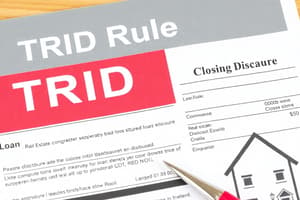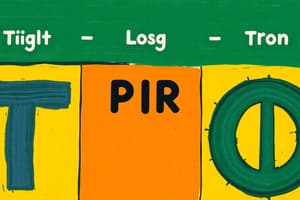Podcast
Questions and Answers
What is the main purpose of the TRID rule?
What is the main purpose of the TRID rule?
- To simplify the loan process for lenders
- To regulate the fees charged by settlement agents
- To eliminate all previous disclosure requirements
- To integrate mortgage disclosures for better consumer understanding (correct)
Which two disclosure forms were replaced by the Loan Estimate under TRID?
Which two disclosure forms were replaced by the Loan Estimate under TRID?
- Good Faith Estimate and HUD 1 Settlement Statement (correct)
- Final Truth-in-Lending Disclosure and HUD 1 Settlement Statement
- Good Faith Estimate and Final Truth-in-Lending Disclosure
- Initial Truth-in-Lending Disclosure and HUD 1 Settlement Statement
Who is responsible for the accuracy of the Loan Estimate and Closing Disclosure?
Who is responsible for the accuracy of the Loan Estimate and Closing Disclosure?
- The CFPB
- Settlement agents
- The borrower
- Lenders (correct)
Which type of loans is NOT covered by the TRID rule?
Which type of loans is NOT covered by the TRID rule?
What does the Closing Disclosure replace under TRID?
What does the Closing Disclosure replace under TRID?
Which entity is responsible for the Seller Closing Disclosure on purchase transactions?
Which entity is responsible for the Seller Closing Disclosure on purchase transactions?
What new form is required for refinance transactions under the TRID rules?
What new form is required for refinance transactions under the TRID rules?
What is a key requirement for lenders regarding the TRID forms?
What is a key requirement for lenders regarding the TRID forms?
What must lenders provide to applicants within three business days of application?
What must lenders provide to applicants within three business days of application?
Which of the following is NOT a requirement for mortgage lenders under the CFPB rules?
Which of the following is NOT a requirement for mortgage lenders under the CFPB rules?
What is an Affiliated Business Disclosure?
What is an Affiliated Business Disclosure?
When must mortgage lenders provide a free copy of all appraisals to the applicant?
When must mortgage lenders provide a free copy of all appraisals to the applicant?
What does the Annual Escrow Account Statement provide for the loan servicer?
What does the Annual Escrow Account Statement provide for the loan servicer?
What is included in the loan costs incurred by the borrower?
What is included in the loan costs incurred by the borrower?
What is the Annual Percentage Rate (APR)?
What is the Annual Percentage Rate (APR)?
Which of the following describes a 'zero tolerance' category under the TRID rule?
Which of the following describes a 'zero tolerance' category under the TRID rule?
What does 'initial escrow payments at closing' primarily cover?
What does 'initial escrow payments at closing' primarily cover?
Which option is considered a 'changed circumstance' under TRID?
Which option is considered a 'changed circumstance' under TRID?
How are lender credits treated concerning total closing costs?
How are lender credits treated concerning total closing costs?
How must the lender document a consumer's intent to proceed?
How must the lender document a consumer's intent to proceed?
What does the Total Interest Percentage (TIP) measure?
What does the Total Interest Percentage (TIP) measure?
Which document must be provided separately from the Loan Estimate when the borrower can shop for settlement services?
Which document must be provided separately from the Loan Estimate when the borrower can shop for settlement services?
Within what time frame must the Loan Estimate be delivered to the consumer?
Within what time frame must the Loan Estimate be delivered to the consumer?
Which of the following would NOT be considered a valid changed circumstance under the TRID rule?
Which of the following would NOT be considered a valid changed circumstance under the TRID rule?
What is the purpose of comparing the Loan Estimate to other Loan Estimates?
What is the purpose of comparing the Loan Estimate to other Loan Estimates?
What constitutes an 'application' under RESPA requirements?
What constitutes an 'application' under RESPA requirements?
What important content is included on Page 1 of the Loan Estimate?
What important content is included on Page 1 of the Loan Estimate?
What is the aggregate tolerance for changes allowed within the ten percent category under TRID?
What is the aggregate tolerance for changes allowed within the ten percent category under TRID?
What must lenders ensure regarding the costs and fees disclosed in the Loan Estimate?
What must lenders ensure regarding the costs and fees disclosed in the Loan Estimate?
When can a consumer modify or waive the seven-business-day waiting period for loan consummation?
When can a consumer modify or waive the seven-business-day waiting period for loan consummation?
What type of charges fall into the 'No Tolerance' category under TRID?
What type of charges fall into the 'No Tolerance' category under TRID?
Which of the following loans is not subject to RESPA?
Which of the following loans is not subject to RESPA?
Which criteria must be fulfilled for a lender to provide a Loan Estimate?
Which criteria must be fulfilled for a lender to provide a Loan Estimate?
When should a revised Loan Estimate be issued due to changed circumstances?
When should a revised Loan Estimate be issued due to changed circumstances?
What defines a 'business day' for the Loan Estimate under TRID?
What defines a 'business day' for the Loan Estimate under TRID?
Which of the following is NOT a valid reason for changes in loan charges?
Which of the following is NOT a valid reason for changes in loan charges?
What must happen to settlement service fees if the lender chooses the service provider?
What must happen to settlement service fees if the lender chooses the service provider?
Which of the following is true regarding mortgage brokers providing the Loan Estimate?
Which of the following is true regarding mortgage brokers providing the Loan Estimate?
Which statement regarding Loan Estimate delivery methods is correct?
Which statement regarding Loan Estimate delivery methods is correct?
What is the significance of the APR disclosed in the Loan Estimate?
What is the significance of the APR disclosed in the Loan Estimate?
What must occur if a lender needs to issue a revised Loan Estimate (LE) due to a change of circumstances?
What must occur if a lender needs to issue a revised Loan Estimate (LE) due to a change of circumstances?
When must a lender ensure that the borrower receives the Closing Disclosure (CD)?
When must a lender ensure that the borrower receives the Closing Disclosure (CD)?
Which scenarios allow lenders to make corrections to a Closing Disclosure after it has been issued?
Which scenarios allow lenders to make corrections to a Closing Disclosure after it has been issued?
What is necessary for a borrower to modify or waive the three-day waiting period after receiving the Closing Disclosure?
What is necessary for a borrower to modify or waive the three-day waiting period after receiving the Closing Disclosure?
How does a revised Closing Disclosure affect tolerance limits?
How does a revised Closing Disclosure affect tolerance limits?
What can be provided as a 'cure' for tolerance violations?
What can be provided as a 'cure' for tolerance violations?
What is the maximum number of days a lender has to issue a corrected Closing Disclosure after learning about the need for a revision?
What is the maximum number of days a lender has to issue a corrected Closing Disclosure after learning about the need for a revision?
Which of the following is included on Page 5 of the Closing Disclosure?
Which of the following is included on Page 5 of the Closing Disclosure?
Under what circumstances can a borrower legitimately waive the three-day waiting period for the Closing Disclosure?
Under what circumstances can a borrower legitimately waive the three-day waiting period for the Closing Disclosure?
When does the right of rescission begin for rescindable transactions after providing the Closing Disclosure?
When does the right of rescission begin for rescindable transactions after providing the Closing Disclosure?
Which of the following statements regarding the Loan Estimate and Closing Disclosure is true?
Which of the following statements regarding the Loan Estimate and Closing Disclosure is true?
What additional disclosures are found on the Closing Disclosure that were not on the Loan Estimate?
What additional disclosures are found on the Closing Disclosure that were not on the Loan Estimate?
Which of the following should a lender NOT do when a Closing Disclosure needs correction?
Which of the following should a lender NOT do when a Closing Disclosure needs correction?
What main purpose does the Closing Disclosure serve?
What main purpose does the Closing Disclosure serve?
Flashcards
TRID Rule
TRID Rule
The TILA-RESPA Integrated Disclosure Rule (TRID), also known as the "Know Before You Owe" rule, integrates mortgage disclosures for consumers.
Loan Estimate
Loan Estimate
The document that replaces the Good Faith Estimate and initial Truth-in-Lending disclosure, providing estimated loan terms.
Closing Disclosure
Closing Disclosure
The document that replaces the HUD-1 settlement statement and final Truth-in-Lending disclosure, providing final loan terms.
Lender Responsibility (TRID)
Lender Responsibility (TRID)
Signup and view all the flashcards
Settlement Agent Responsibility
Settlement Agent Responsibility
Signup and view all the flashcards
CFPB-provided Forms
CFPB-provided Forms
Signup and view all the flashcards
TRID Exceptions
TRID Exceptions
Signup and view all the flashcards
TRID and RESPA/TILA
TRID and RESPA/TILA
Signup and view all the flashcards
Affiliated Business Disclosure
Affiliated Business Disclosure
Signup and view all the flashcards
Initial Escrow Account Statement
Initial Escrow Account Statement
Signup and view all the flashcards
Loan Estimate (LE)
Loan Estimate (LE)
Signup and view all the flashcards
Closing Disclosure (CD)
Closing Disclosure (CD)
Signup and view all the flashcards
Annual Escrow Account Statement
Annual Escrow Account Statement
Signup and view all the flashcards
TRID
TRID
Signup and view all the flashcards
Appraisal Requirements
Appraisal Requirements
Signup and view all the flashcards
Waiver of 3-Day Appraisal Provision
Waiver of 3-Day Appraisal Provision
Signup and view all the flashcards
Annual Percentage Rate (APR)
Annual Percentage Rate (APR)
Signup and view all the flashcards
Total Interest Percentage (TIP)
Total Interest Percentage (TIP)
Signup and view all the flashcards
Loan Consummation
Loan Consummation
Signup and view all the flashcards
Business Day (LE)
Business Day (LE)
Signup and view all the flashcards
Business Day (CD)
Business Day (CD)
Signup and view all the flashcards
Intent to Proceed
Intent to Proceed
Signup and view all the flashcards
Changed Circumstance
Changed Circumstance
Signup and view all the flashcards
Application
Application
Signup and view all the flashcards
Seven-Day Waiting Period
Seven-Day Waiting Period
Signup and view all the flashcards
Loan Estimate Delivery Time
Loan Estimate Delivery Time
Signup and view all the flashcards
Loan application information
Loan application information
Signup and view all the flashcards
Required Loan Estimate Content
Required Loan Estimate Content
Signup and view all the flashcards
Loan Costs
Loan Costs
Signup and view all the flashcards
Origination Charges
Origination Charges
Signup and view all the flashcards
Third-Party Charges (Shoppable)
Third-Party Charges (Shoppable)
Signup and view all the flashcards
Third-Party Charges (Non-Shoppable)
Third-Party Charges (Non-Shoppable)
Signup and view all the flashcards
Prepaids
Prepaids
Signup and view all the flashcards
Escrow
Escrow
Signup and view all the flashcards
Lender Credits
Lender Credits
Signup and view all the flashcards
Cash to Close
Cash to Close
Signup and view all the flashcards
Good Faith Estimate (GFE)
Good Faith Estimate (GFE)
Signup and view all the flashcards
Tolerance
Tolerance
Signup and view all the flashcards
Zero Tolerance
Zero Tolerance
Signup and view all the flashcards
Change of Circumstances
Change of Circumstances
Signup and view all the flashcards
Settlement Services
Settlement Services
Signup and view all the flashcards
Settlement Service Providers List
Settlement Service Providers List
Signup and view all the flashcards
Revised LE Impact
Revised LE Impact
Signup and view all the flashcards
Revised LE Timing
Revised LE Timing
Signup and view all the flashcards
Tolerance Cures
Tolerance Cures
Signup and view all the flashcards
Closing Disclosure Timing
Closing Disclosure Timing
Signup and view all the flashcards
CD Timeline
CD Timeline
Signup and view all the flashcards
CD Waiting Period Waiver
CD Waiting Period Waiver
Signup and view all the flashcards
CD Changes Before Closing
CD Changes Before Closing
Signup and view all the flashcards
CD Correction Timeline
CD Correction Timeline
Signup and view all the flashcards
Revised CD Waiting Period
Revised CD Waiting Period
Signup and view all the flashcards
CD After Closing
CD After Closing
Signup and view all the flashcards
CD Page 1
CD Page 1
Signup and view all the flashcards
CD Page 2
CD Page 2
Signup and view all the flashcards
CD Page 3
CD Page 3
Signup and view all the flashcards
CD Page 4
CD Page 4
Signup and view all the flashcards
CD Page 5
CD Page 5
Signup and view all the flashcards
Study Notes
TRID (TILA-RESPA Integrated Disclosure) Rule
- Replaced dual RESPA (Reg X) and TILA (Reg Z) disclosure requirements with integrated Loan Estimate (LE) and Closing Disclosure (CD) forms.
- Effective October 3, 2015.
- Lenders are fully responsible for the accuracy of both the LE and CD.
- Applies to most federally-related mortgage loans secured by real property or cooperative units.
- Excludes HELOCs, reverse mortgages, chattel-dwelling loans, and loans by non-creditors.
- Some exceptions for low-income borrower assistance and certain types of TILA-subject but non-RESPA loans (construction, vacant land, or large acreage loans, and some credit extended to trusts).
Loan Estimate (LE)
- Replaces Good Faith Estimate (GFE) and initial Truth-in-Lending disclosure.
- Required delivery within three business days of application receipt.
- LE must contain good faith estimates of costs and terms.
- Key aspects include: General Loan information, detailed breakdown of costs, cash-to-close estimate, APR and TIP, comparisons, and additional information (appraisal needs, assumption possibilities, future refinancing implications).
- Lender is responsible for errors in the LE.
Closing Disclosure (CD)
- Replaces final Truth-in-Lending disclosure and HUD-1 settlement statement.
- Required delivery no later than three business days before consummation.
- Contains final transaction terms and costs.
- Reflects actual amounts where possible.
- Must be updated for any substantial changes.
- Lenders are responsible for accuracy, but may estimate aspects when necessary.
Key Terminology
- Annual Percentage Rate (APR): Annualized cost of borrowing including fees.
- Total Interest Percentage (TIP): Total interest paid over the loan life divided by the loan amount.
- Loan Consummation: The point when a borrower becomes legally obligated; determined by state law.
- Business Day (LE): Days when lender offices are open for most business activities.
- Business Day (CD): All calendar days except Sundays and legal holidays
- Intent to Proceed: Borrower’s declaration of intent to move forward with the loan. Documentation is required.
- Changed Circumstances: Specific events (e.g., changes in creditworthiness) permitting revised disclosures or resetting tolerance limits.
Tolerance Categories
- Some variations between disclosed and actual costs are allowed.
- Zero Tolerance Applies to certain lender charges, rates, or fees which must match estimates.
- 10% Tolerance Allows for up to a 10% variance from disclosed estimates with changed circumstances.
- No Tolerance Applies to certain costs like prepaid interest and escrow amounts.
Additional Disclosures and Requirements
- Settlement/Service Providers List: Lenders must provide a list of settlement service providers if shopping is allowed.
- Affiliated Business Disclosure: When lender affiliations exist.
- Free Appraisal Copies: Lenders must promptly provide copies of appraisals, often within three days of report completion (but may be waived) - Especially for high-value loans.
- "Your Home Loan Toolkit": Explains TRID disclosures and the home-buying process.
Key Differences Between LE and CD
- CD is the definitive, final disclosure
- LE provides estimates, and is subject to revision.
- The structures and content are similar.
- Key content differences (seller-side vs refinances)
- CD provides final amounts, including seller or third-party payments and includes summaries for transactions accounting for categories similar to LE format
Studying That Suits You
Use AI to generate personalized quizzes and flashcards to suit your learning preferences.




